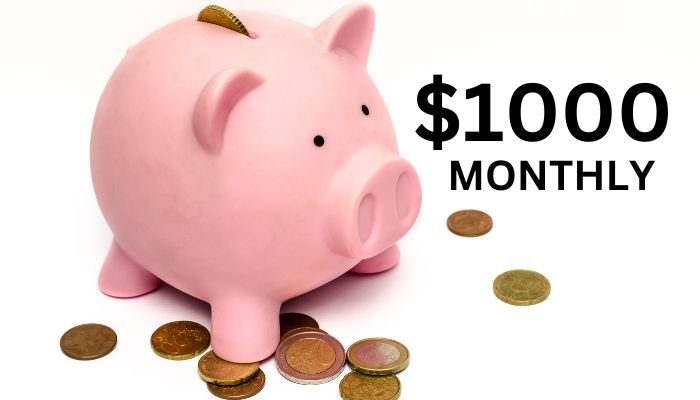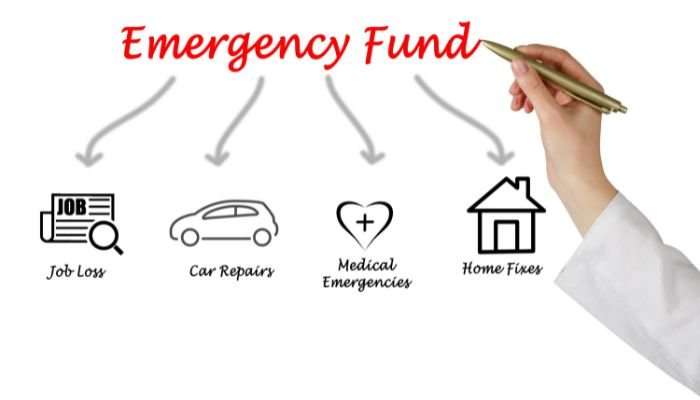Disclaimer: This post may contain affiliate links, meaning we get a small commission if you make a purchase through our link at no extra cost to you. For more information, please visit our Disclaimer Page.
Learning how to save $1,000 a month might seem overwhelming, but it’s more achievable than you think.
Most of us feel stretched by everyday expenses like rent, groceries, and utilities. Add in unexpected costs, and saving money feels impossible.
But here’s the good news: with the right strategies, you can take control of your finances and hit that $1,000 savings goal every month.
Let’s get into practical, no-nonsense ways to help you save, so you can breathe easier and start building the financial future you deserve..
Key Takeaways
- Cut back on everyday expenses by canceling unused subscriptions and switching to cheaper brands.
- Plan shopping and meals to avoid impulse buys and take advantage of bulk discounts.
- Adopt mindful spending habits like waiting 30 days before big purchases and setting clear savings goals.
- Boost income through side gigs, selling items online, or using cashback and rewards programs.
- Leverage budgeting apps and automate your savings for a seamless financial strategy.
Here are the 25 ways on How To Save $1,000 A Month?
1. Track Your Spending
Understanding where your money goes is the first step to saving. Use budgeting tools like Mint or YNAB (You Need A Budget) to categorize expenses and spot areas to cut back. Reviewing your spending weekly or even daily helps you stay more aligned with your financial goals.
Why is tracking expenses important for saving money?
Tracking your expenses uncovers patterns in your spending habits.
For instance, you might discover that impulse purchases or frequent dining out are eating into your budget, giving you a clear starting point for adjustments.
2. Create a Detailed Budget
Adopt the 50/30/20 budgeting method:
- 50% for needs (rent, groceries).
- 30% for wants (entertainment).
- 20% for savings.
Apps like EveryDollar make this process seamless by guiding you through budget creation.
3. Meal Plan and Cook at Home
Eating out or ordering takeout adds up quickly. Meal prepping can save you hundreds of dollars each month.
Use tools like Mealime or Budget Bytes for affordable, easy-to-follow recipes.
Consider batch cooking or freezing meals for added convenience, ensuring you always have a cost-effective option ready when time is tight.
Bonus Tips:
- Shop with a grocery list to avoid impulse purchases.
- Use cashback apps like Ibotta for savings on groceries.
How does meal prepping save money?
Planning meals in advance reduces food waste, minimizes impulse purchases, and eliminates the need for last-minute expensive takeout.
4. Cut Unnecessary Subscriptions
Evaluate recurring charges for streaming services, gym memberships, and apps. Cancel what you don’t use or switch to cheaper options.
According to a study by C+R Research, the average person spends about $133 per month on subscriptions, and canceling unused ones can save hundreds annually.
Services like Rocket Money (formerly Truebill) help identify and cancel subscriptions.
5. Use Cashback and Reward Programs
Apps like Rakuten and Honey offer cashback on purchases.
These small savings accumulate over time, boosting your monthly savings.
6. Switch to Generic Brands
Store-brand products are often just as good as name-brand items but significantly cheaper.
This simple switch can reduce grocery bills by 20-30%.
7. Automate Your Savings
Set up automatic transfers to a high-yield savings account.
Apps like Acorns round up your purchases and invest the spare change, making saving effortless.
What is the best high-yield savings account?
High-yield savings accounts like Ally or Marcus by Goldman Sachs often offer competitive interest rates, making your money work for you.
8. Reduce Utility Bills
Cut energy costs by:
- Switching to energy-efficient appliances.
- Using a programmable thermostat.
- Turning off lights and unplugging unused devices.
Visit Energy Star for more energy-saving tips.
How can I lower my electricity bill fast?
Simple actions like adjusting your thermostat, using LED bulbs, and sealing windows can significantly reduce your monthly electricity bill.
9. Carpool or Use Public Transport
Save on gas and parking by carpooling with apps like Waze Carpool or using public transportation. Cycling or walking short distances can also reduce commuting costs.
10. Shop Second-Hand
Thrift stores, consignment shops, and online platforms like ThredUp and Poshmark offer quality items at a fraction of retail prices.
11. Refinance Loans
Lower monthly payments by refinancing high-interest loans.
Use platforms like SoFi or LendingTree to compare rates and find better deals.
12. Plan Purchases Strategically
Time big purchases around sales events like Black Friday or end-of-season clearances.
Use price-tracking tools like CamelCamelCamel for Amazon deals.
13. Limit Dining Out
Reduce restaurant visits by cooking at home. Try meal kits from Dinnerly for affordable, easy-to-prepare meals.
Dining out only for special occasions can save hundreds monthly.
14. Negotiate Bills
Call your service providers to negotiate lower rates on internet, cable, and insurance. Services like Billshark or Trim can handle negotiations for you.
Can you really negotiate bills?
Yes, many companies are willing to offer discounts or promotions to retain customers, especially if you mention competitive offers.
15. Declutter and Sell Unused Items
Turn unused belongings into cash by selling them on platforms like eBay, Facebook Marketplace, or OfferUp.
16. Embrace Free Entertainment
Replace costly outings with free activities like hiking, community events, or library programs.
Websites like Eventbrite list free or low-cost events in your area.
17. Start a Side Hustle
Find ways to make extra money by starting a side gig: freelancing, tutoring, or selling handmade items.
Platforms like Fiverr and Etsy provide opportunities to monetize your skills.
What are the best side hustles for extra income?
Popular options include virtual assistance, content creation, tutoring, and e-commerce.
18. Practice the 30-Day Rule
Avoid impulse purchases by waiting 30 days before buying non-essential items.
Apps like PocketGuard can remind you to evaluate your spending decisions.
19. Buy in Bulk
Save on groceries and household essentials by buying in bulk from stores like Costco or Sam’s Club.
Compare unit prices to ensure real savings.
20. DIY Home Projects
Learn basic home repairs and upgrades through YouTube tutorials. Handling minor fixes yourself can save on costly professional services.
21. Participate in Online Surveys
Websites like Survey Junkie or Swagbucks pay you to share your opinions.
While not a primary income source, survey earnings can supplement your savings.
22. Bundle Insurance Policies
Combine auto, home, and other insurance policies with the same provider for discounts.
Compare options using platforms like Policygenius.
23. Use Public Libraries
Libraries offer free access to books, movies, and even eBooks.
Some also provide free courses, workshops, and access to software like Adobe Suite.
24. Opt for Free Fitness Options
Save on gym memberships by exercising at home or outdoors.
Apps like FitOn provide free workout routines. Local parks often have free fitness classes or equipment.
How to Save $1,000 in 30 Days challenge
The “How to Save $1,000 in 30 Days” challenge is a practical, structured approach to achieving a financial goal within a set timeframe.
It helps individuals focus on their spending habits and prioritize savings through actionable steps. Here’s why it’s essential:
- Clear Target: Provides a concrete goal, making it easier to track progress.
- Discipline: Encourages better budgeting and cutting unnecessary expenses.
- Financial Awareness: Raises awareness about spending habits.
- Motivation: Instills a sense of accomplishment and confidence.
By following this challenge, individuals can achieve their $1,000 goal while cultivating better financial habits.
How to Save $1,000 in 30 Days: Daily Breakdown
To reach your $1,000 savings goal in 30 days, here is a realistic daily savings plan. Adjust as needed to fit your budget:
| Day | Amount to Save ($) |
|---|---|
| 1 | 10 |
| 2 | 15 |
| 3 | 10 |
| 4 | 20 |
| 5 | 15 |
| 6 | 10 |
| 7 | 20 |
| 8 | 15 |
| 9 | 10 |
| 10 | 25 |
| 11 | 10 |
| 12 | 15 |
| 13 | 10 |
| 14 | 20 |
| 15 | 15 |
| 16 | 10 |
| 17 | 25 |
| 18 | 15 |
| 19 | 10 |
| 20 | 20 |
| 21 | 15 |
| 22 | 10 |
| 23 | 25 |
| 24 | 10 |
| 25 | 15 |
| 26 | 10 |
| 27 | 20 |
| 28 | 15 |
| 29 | 10 |
| 30 | 25 |
| Total | $1,000 |
$1000 in 30 days printable free excel sheet download template pdf
Conclusion: How To Save $1,000 A Month
Saving $1,000 in 30 days is achievable with discipline, planning, and the use of the tools and strategies outlined above.
By following the 20 smart ways and tracking your daily savings with our printable, you’ll stay on course toward your financial goals.
Start today, and in just one month, you’ll see the impact of these small, consistent actions!





